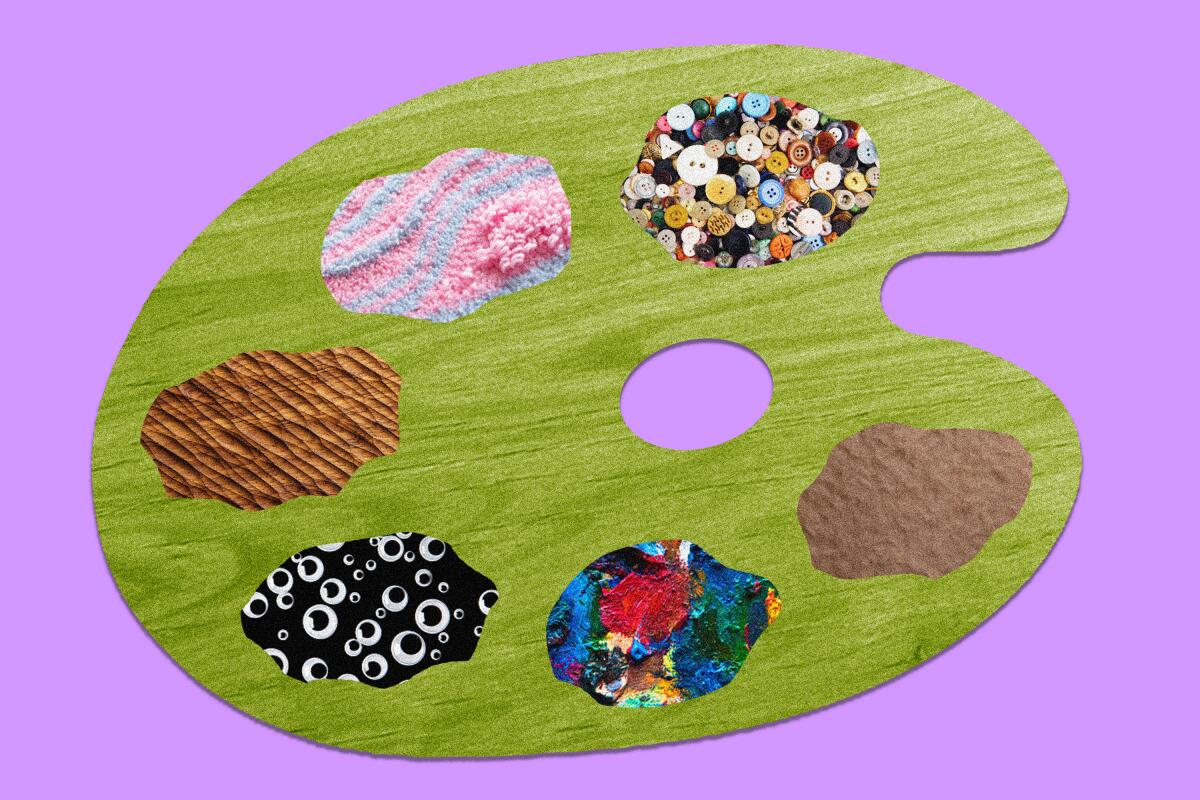
11 places in L.A. to get your creativity flowing. Pottery! Neon bending! Bookbinding!
- Share via
I’ve been envious of people with crafty hobbies. Even though I’m a full-time writer, the idea of making something new just because it’s fun somehow felt out of my reach. For years, I’d watch my mom make fresh jam and my roommates screen print designs onto tank tops, wishing I had my own craft to hone.
So when I moved to Los Angeles last summer, I promised myself that I’d finally take that pottery wheel class I’d been contemplating. After unintentionally making a lot of tiny shot glasses, I began throwing bowls and fancy little ashtrays that I’ve turned into a sort of show-and-tell whenever new people come over to my house. The things I’ve made are by no means masterpieces, but I’ve been making new friends and embracing the beauty of learning (and sometimes failing). I’m still hoping to make a full-size vase or plate, but in the meantime, I started to wonder what else I could learn around this city.
Planning your weekend?
Stay up to date on the best things to do, see and eat in L.A.
As you might expect, L.A. has spaces where you can try just about anything. From candle making to Jaipur block printing and woodworking, there’s someone who can teach you any art form you can dream up. So if you’re itching to try out a new craft, here are 11 places where you can get started. (Note: Certain classes may not be currently offered. Check the websites for upcoming schedules.)
These Hands Maker’s Collective
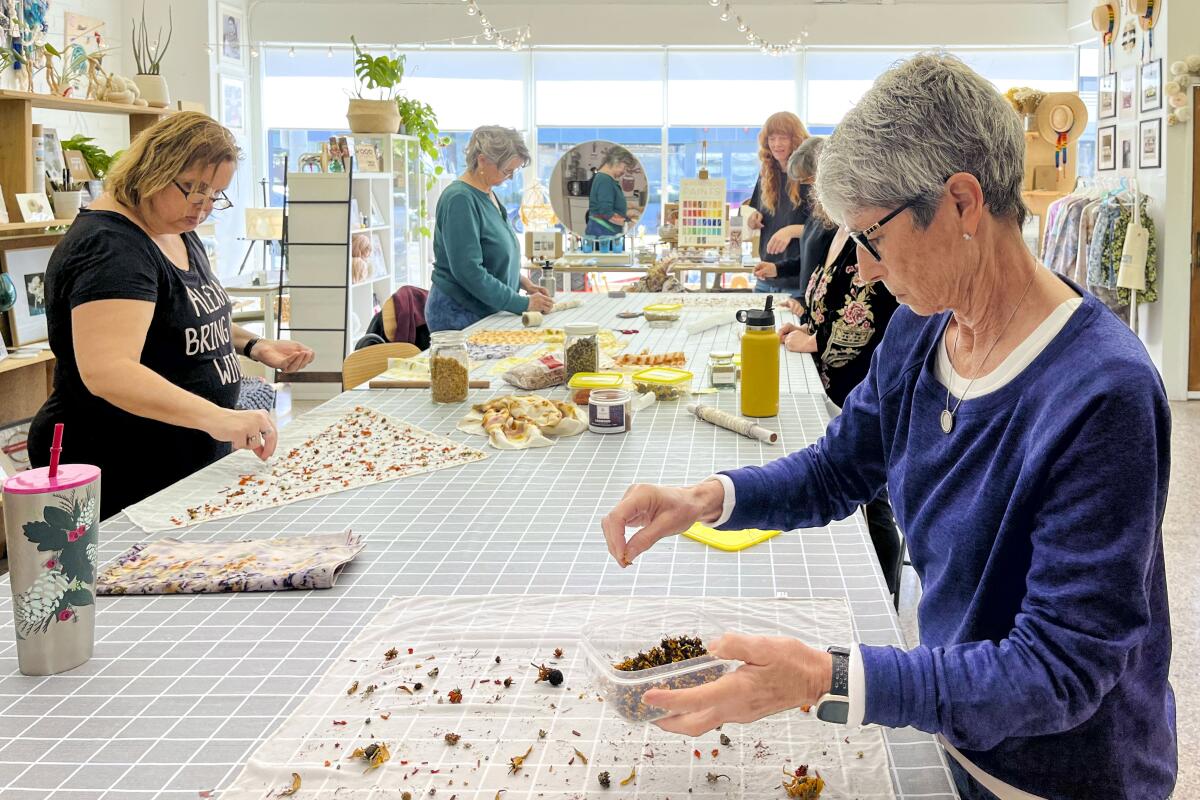
These Hands Maker’s Collective feels more like someone’s well-equipped home studio than a storefront.
Denise Ambrosi, who started the collective about five years ago, opened the current space — a sunny, open workshop on Washington Boulevard — last April. With craft supplies for sale, co-working stations for artists-in-residence and large tables for classes, These Hands draws neighbors and crafty friends from around the city. It’s also home to Moving Thread, which hosts sewing workshops for all different skill levels.
“I want it to be a creative community,” Ambrosi said. “I want people to be able to come here and feel like it’s a place where they can come and relax, and just kind of get out of their heads and get off their phones.”
Though many of the classes at These Hands are focused on fiber arts — weaving, embroidery, knitting, crocheting, punch needle and fabric dyeing are just a few of the options — you can also try courses like jewelry making, paper cutting and even chocolate tasting. (The company also hosts corporate team-building events.)
“We have a chocolate teacher who works with us from [the] Gourmandise School of cooking,” Ambrosi explained. “It’s a mixture of creative tasting, where you taste a piece of chocolate and then you paint what you taste.”
I stopped by on a Sunday morning for a bundle dyeing class, in which we learned how to use flowers, plant matter and small bugs to dye cotton and silk bandannas. As we began laying out petals and wood chips to create designs, we could hear the resident jewelry maker begin her own work.
After steaming our bundled, decorated fabrics, it was time to unfurl them for the big reveal. As we brushed off the dyeing materials, everyone seemed eager to share and compliment one another’s work. Before the class was even over, half of the students had already signed up for the next fabric dyeing event.
“I just feel like we need this more than we know,” Ambrosi said of the workshops she hosts. “The anxiety levels are so high right now, and I think this is certified treatment.”
Allied Woodshop
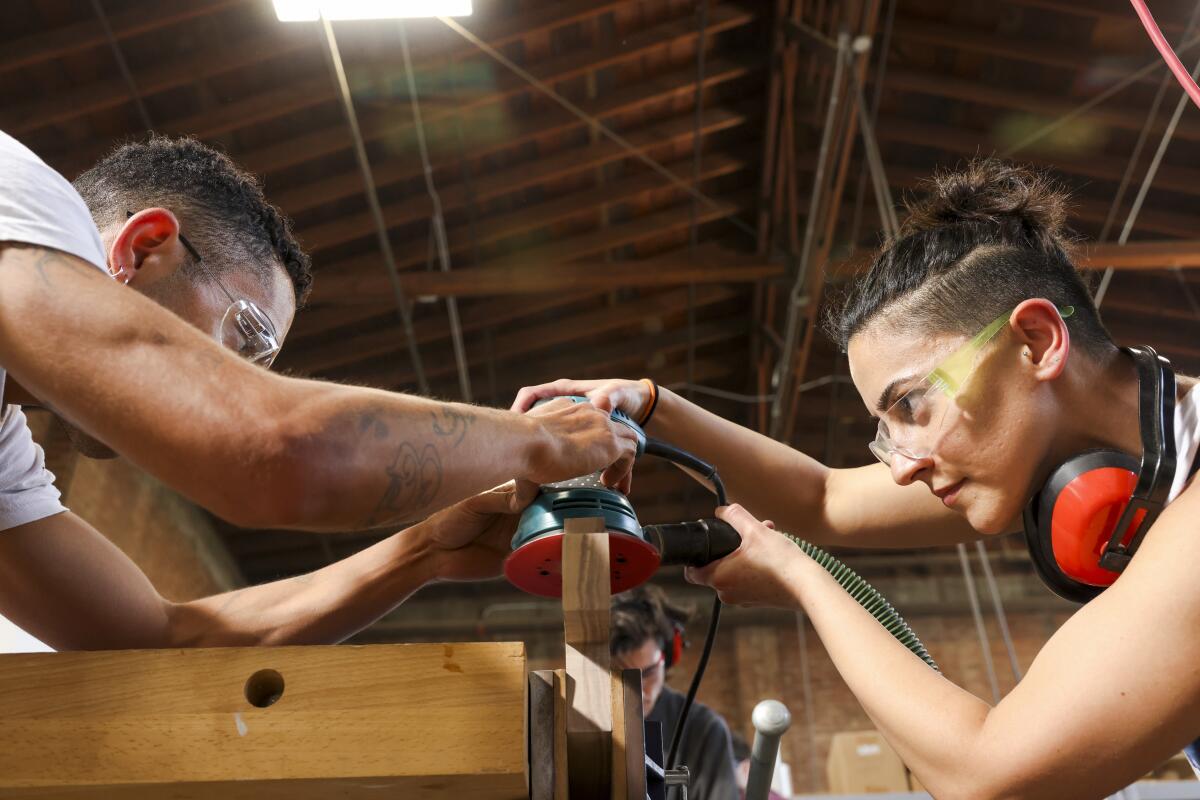
Woodworking usually comes with a trifecta of challenges: Equipment is expensive, sharp blades can be dangerous and most projects require quite a bit of space.
But Allied Woodshop, based just east of downtown Los Angeles, offers students the chance to learn the basics and give woodworking a try. Though the Intro to Woodworking class is $260, the courses are six hours long and cover the entire process of designing and making a cutting board. According to Lauren Verdugo, who’s been woodworking since 2016 and teaching at Allied Woodshop for two years, “You get a lot for how much you pay in terms of skill.”
During the class I took, we were offered the choice of three types of wood: walnut, cherry and maple. Every Intro to Woodworking class goes over the use of a planer, table saw, band saw, jointer and drill press, with demonstrations and safety precautions for each machine.
“Anytime we turn on a machine, we automatically go over a safety demo, regardless of people’s skill sets — or whatever they lie about,” Verdugo said.
Throughout the class, we were offered different options and guidance. Though some of my classmates wanted more sleek and Midcentury Modern looking boards, I decided to turn my cherry wood into what I call the “bean board”: a kidney bean-shaped charcuterie board that I labeled with “BEANS” on one side and “NO BEANS” on the other.
The woman-owned community wood shop offers several levels of classes and studio space for more experienced woodworkers who are interested in setting up a residency. As the shop mentions in each class description, there’s at least one woman or trans/nonbinary person leading each course, with some classes led by and designated specifically for female, trans and nonbinary students.
Remainders Creative Reuse

Anyone who has run up a bill at an art supply store probably has dreamed about a place like Remainders Creative Reuse.
The first floor of the center features 3,000 square feet of discounted art supplies, all donated by local businesses and community members. Items start at 50 cents (and mostly stay under $3) — you’ll find bins of assorted buttons, paints, fabrics, googly eyes and other crafting materials. Upstairs, there’s an equally huge space where you can take classes like indigo dyeing, color theory and needle felting, while using the supplies available downstairs.
“If we don’t have something on hand, we don’t have that class,” said Toban Nichols, the director of education and development. That allows Remainders to keep many classes around $25 — notably cheap for activities that usually require pricy materials.
Most of Remainders’ classes host about a dozen people, though sewing classes are capped at eight (since there are only eight sewing machines). One of the most popular classes Nichols teaches is Jaipur block printing — a technique that involves printing a pattern onto fabric with carved wood blocks and ink.
“The classes here are meant to be fun and easy, not difficult,” Nichols said. “We don’t do any pressure.”
Nichols said that Remainders has a dedicated group of regulars who are mostly retirees but recently has been drawing younger crowds who learned about the store through social media. Scholarships are available for all of the classes.
“If someone wants to take [a class] and they really can’t afford it, we just let them take the class,” Nichols said.
Museum of Neon Art

For anyone curious about how the bright, glowing neon signs around Los Angeles are made, the Museum of Neon Art offers an array of classes.
Leticia Maldonado, a neon artist and one of the museum’s newer teachers, said she was a bit nervous before leading her first class but quickly found her footing. “When you’re working on neon, it’s something very solitary, like you’re in your studio by yourself a lot of the time,” she said. “I thought it was going to be very draining [to be with a group], but it was the opposite.”
Maldonado focuses on pattern-based classes (which means that students bend glass tubes to match a predesigned pattern), but most of the beginner classes at MONA cover the same basics of working with neon glass over fire. One exciting part of the process: choosing a noble gas that will glow when charged.
“You can do just straight, pure neon, which is that, like, classic, bright orange-red color,” Maldonado said. “You can do straight, pure argon, which is a really pretty light violet color that’s a little more dim. You can add mercury to the argon, which makes it much brighter and makes it bright blue. Or you can add your mercury to neon [and] every time you plug it in over time, initially, it’ll be that bright orange red, and then over the course of maybe like 30 minutes, the mercury will slowly vaporize and turn the whole unit blue.”
One-day workshops start at $300 and the museum’s eight-week studio labs are around $1,650.
“It’s cool because at the end of the one-day classes that I teach, you leave with a completely finished glowing neon tube that you bent yourself,” Maldonado said. “You can hang it up and light it up immediately.”
Hand Follows Eye

In early 2022, Rachel Deane and Mads Gobbo created Hand Follows Eye as a fun and expansive space where people can explore figure drawing without judgment. The mobile art school — which hosts pop-up workshops at locations around L.A., including Glendale’s Junior High — guides artists of every skill level in constructing figures with colored pencils, markers, charcoal and other supplies.
“In our culture, we have all of these kinds of images of the body that are presented to us constantly, and they’re perfected images — they’re idealized images,” Gobbo said. “In art schools, you’re approaching figure drawing from this sort of, like, platonic ideal perspective, looking at how to create the most compelling anatomies. I think part of our practice of queering figure drawing is to look at the body as this holistic thing, as this incredible tool that we all have that works perfectly in its own way.”
Though all-ages classes feature clothed models, the attire (or lack thereof) at each 18+ drawing class is entirely up to the model’s discretion. After the classes cycle through both quick and longer poses, everyone is encouraged to leave a drawing out and take a lap around the room to see how each person interpreted the model.
Classes are $15, but Deane and Gobbo offer scholarship tickets for every workshop. They want everyone who wants to participate to be able to do so.
“The most wonderful thing that has come out of Hand Follows Eye for me [is that it] has really helped me on my own gender journey and accepting my body as it is,” Gobbo said. “And so I hope that our students have that feeling leaving our classes as well.”
Stone Candle Bar
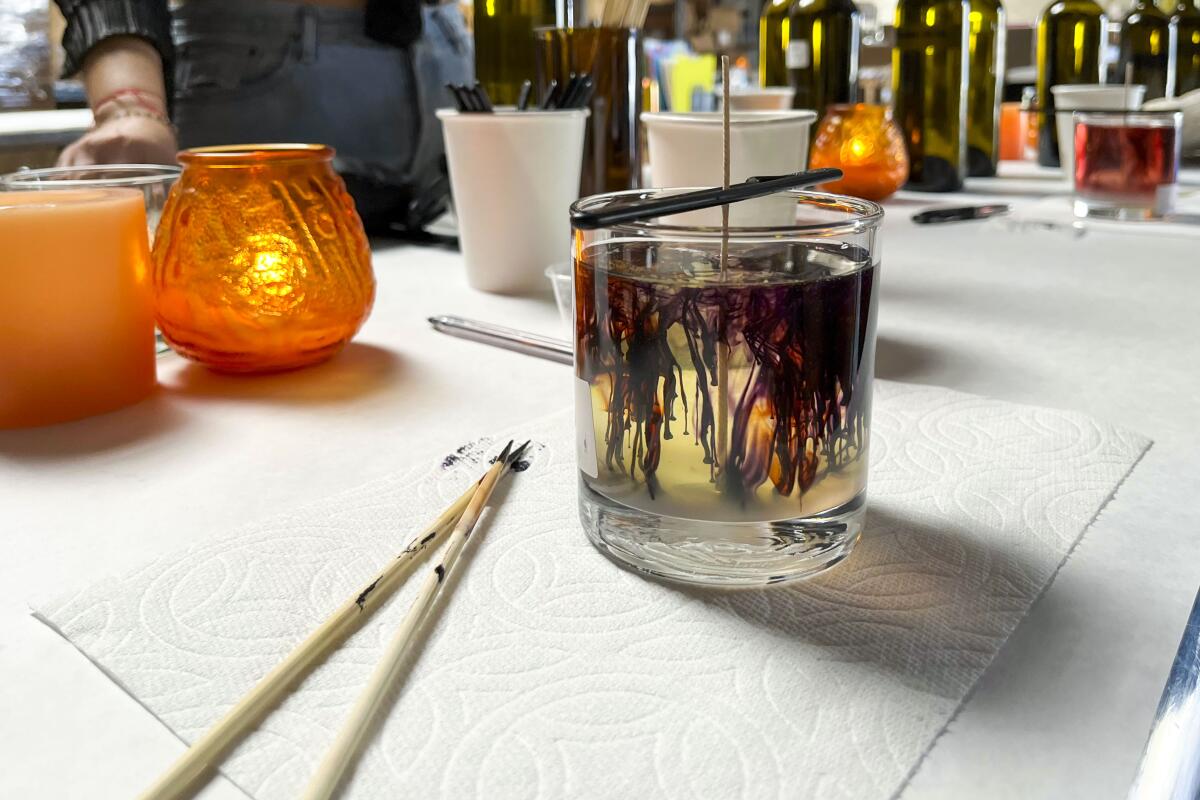
Inside an Inglewood warehouse, Stone Candle Bar hosts intimate candle-making classes every Saturday.
Anya Kovalyk, who’s been teaching at Stone Candle Bar for four years, leads both the basic candle-making class in the morning and a crystal intention candle-making class in the afternoon.
“I was always into candles,” Kovalyk said. “My dad used to make candles with the harder wax where you [can] carve sculptures. Fragrances too. I think it’s beautiful what you can evoke — your memories and just learning a little bit more about yourself and [your] senses in general.”
At the start of the class I attended, we were invited to pick three scents from a wall of about 160 bottles. I chose “Cassis,” “Wonderwood” and another blend called “Gin & Rosewater Tokyo Milk.”
As the seven of us settled into our workstations with our fragrance bottles, Kovalyk guided us through the process of putting safety labels on our candle containers, blending our scents and mixing them into warm wax.
Once our wax was poured and scented, we customized our candles by adding colors to the wax. Although the scents and colors seemed a bit bold at first, they mellowed after 20 minutes in the freezer.
In addition to in-person candle making classes, Stone Candle Bar offers online classes with kits shipped straight to your home. Although in-person classes start at $60, promotions often are available online.
“In the end, I think everybody’s super happy,” Kovalyk said. “You have something you created with your own hands. You put your soul into it. It’s exciting.”
Tac-Tile Mountain
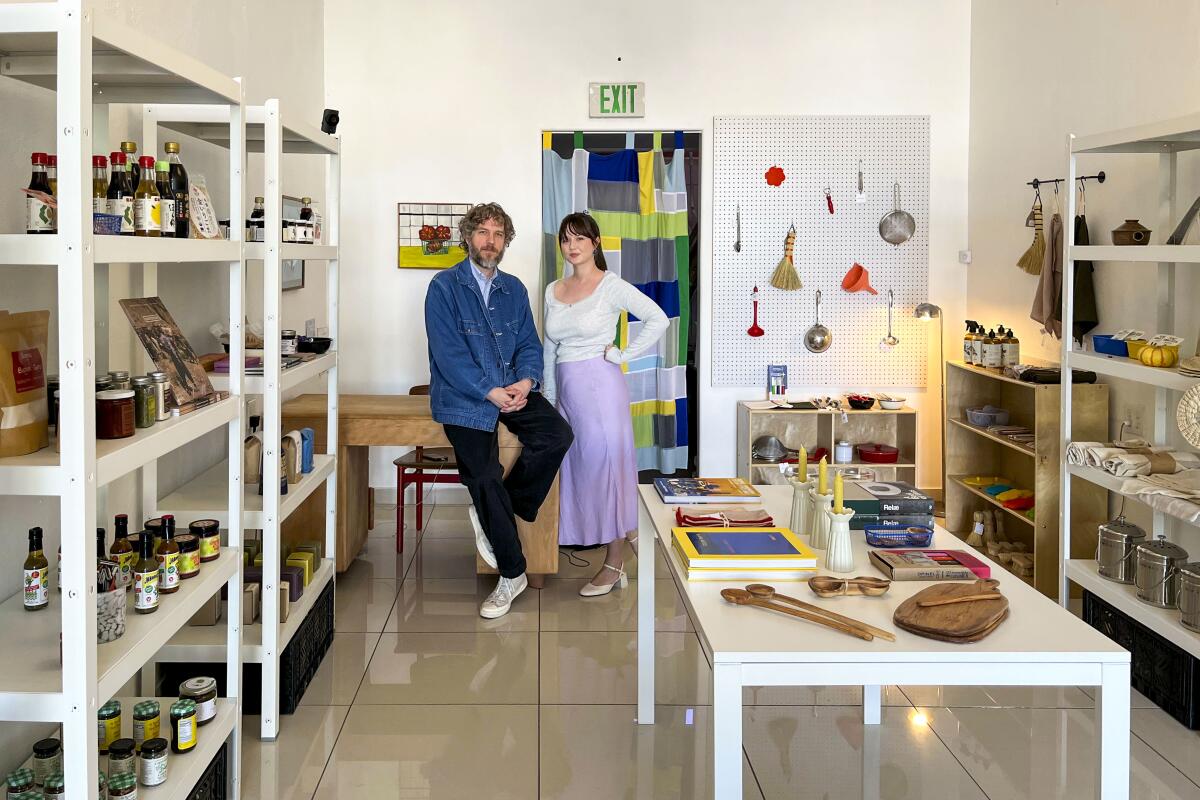
Tac-Tile Mountain is best explained as a store for all the senses. As co-owners Nico Yaryan and Scarlett Rose Patterson put it, it’s an intentionally undefinable space where you can buy both sardines and vibrators.
“We wanted to have a store that sort of encapsulated all the things that we like,” Yaryan said before rattling off a long list of interests. “We’re really into cooking. And we like the home and homewares and handmade things.”
Opened just six months ago, the space has become a home for an eclectic roster of workshops that include pickling, incense making, bookbinding and breathwork.
“I thought that this space would be a nice space [for workshops] because everyone always comes in and they’re like, ‘It’s so calming in here,’” Patterson said.
Jess Wang, the fermented food enthusiast behind Los Angeles-based workshops known as Picklé, recently taught a class at Tac-Tile Mountain. She said the 18-person fermenting class sold out quickly once it was announced.
“There was one student who was dressed in a vegetable-themed outfit, including beaded earrings that were all vegetables and a dress with a full-on vegetable pattern,” Wang said.
Patterson and Yaryan cleared the center of the room, set up tables and chairs and watched as community members created things together.
“Scarlett and Nico were really sweet and accommodating,” Wang said. “They let me use their checkout desk to prepare snacks — I was making fermented pancakes on a griddle.”
Nova Community Arts

Tucked above a tattoo studio in a vibrant pink-and-green space, Nova Community Arts hosts a variety of art classes that range from printmaking and painting to letterpressing and bookmaking.
Gray Lamb, the co-director and co-founder of Nova, said that the idea for the space came about after being unable to find a local letterpress studio. Lamb and co-founder Rosie Mayer soon began dreaming of a space where they could offer a variety of art classes.
“We really wanted to make a space that is kind of the camaraderie of art school without the pressure of art school,” Lamb said. “You get to be around, like, other artists and other people without it being, like, ‘Oh, you feel like making a piece of capital-A Art?’”
Nova offers workshops and classes several nights a week. Each Thursday, it specifically offers LGBTQ+ workshops, which range from risograph printing to linoleum carving.
Jason Peckham, who teaches oil painting at Nova, said the space gives people the chance to try something expensive without shelling out money for all the supplies.
“When I was trying to learn how to oil paint, I felt like I didn’t know what supplies to buy, and it was very frustrating because they’re pretty expensive,” he said. “Like a tube of red oil paint can cost $40 ... and you don’t even necessarily know if you like oil painting yet. I just wanted to have a class that was more exploratory.”
Lamb said each class is usually six to eight people, and scholarships are offered for those who need them via an online form.
The Glass Studio at the Makery
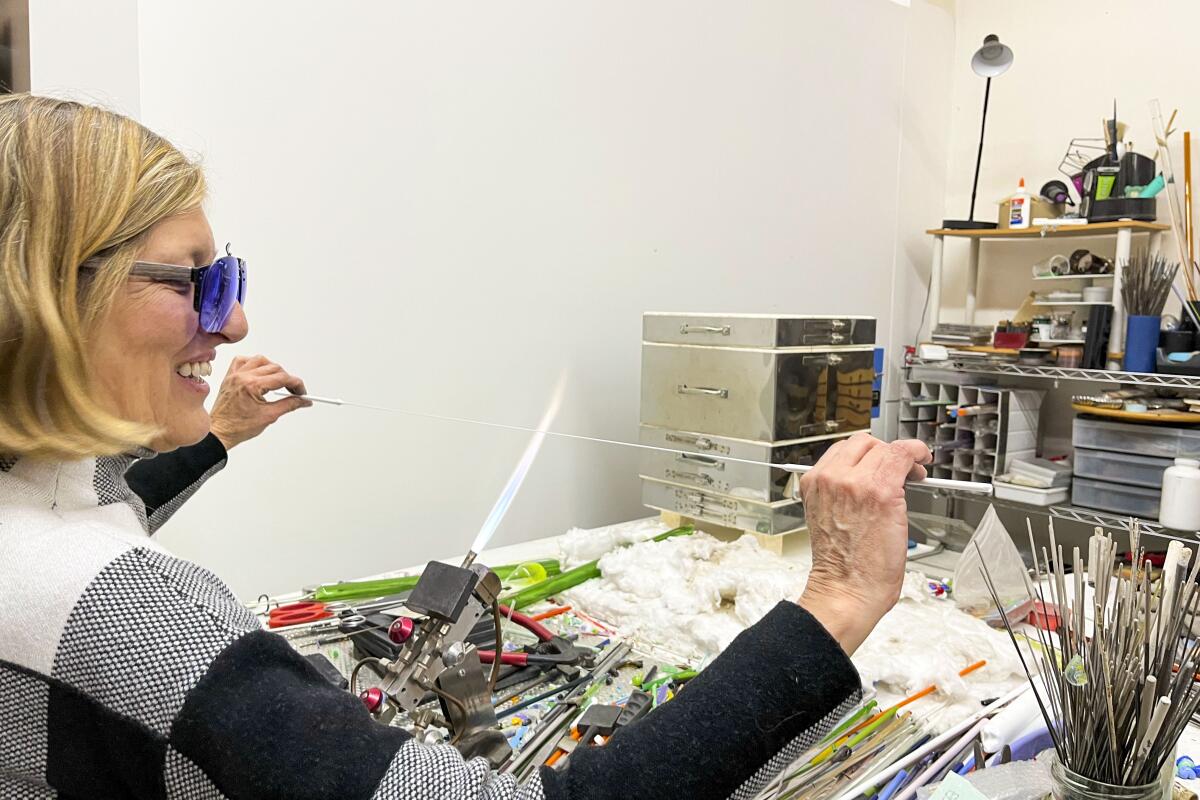
Cathi Milligan has been teaching Californians how to work with glass for more than 25 years. Offering a variety of classes under the name the Glass Studio, she works at both the Makery in Little Tokyo and Pacific Art Glass in Gardena.
“Anybody can walk in here and try to learn about glass,” Milligan said. “If somebody just wants a taste, they can make a pendant — $75 — or the tile class — $100. But, you know, inevitably everybody wants to melt glass.”
Well before the glass-blowing TV show “Blown Away” became popular, Milligan was teaching people the basics of bead making. She currently teaches at the Makery once or twice each week — far more than her once-a-month glass blowing classes in Gardena.
Her classes at the Makery are small — usually one or two students, since she has only so many torches — and take students through the basics of how to safely work with glass and create small beads.
“The first thing I’m going to teach somebody is how to make stringer,” she said, referring to the malleable, hot threads that people pull from chopstick-size glass rods. As she set up a small torch clamped to the edge of her work table, she instinctively narrated the process of turning on its propane and oxygen lines.
“I’m just growing this little mass,” she said as she rolled the rods and wrapped the stringer into a smooth, round orb, “and then I’m gonna wait a moment, because if I pull too fast, it’s too hot.”
Though many of her students only take one class to check off their bucket lists, Milligan said she also offers a few higher-level classes that have prerequisites. But even when she’s teaching her most basic introductory classes, Milligan has one request for all her new students: “Please watch ‘Blown Away,’” she said. “Because I’m going to talk to you about stuff that — if you watch it — you’ll start to recognize.”
The Pottery Studio
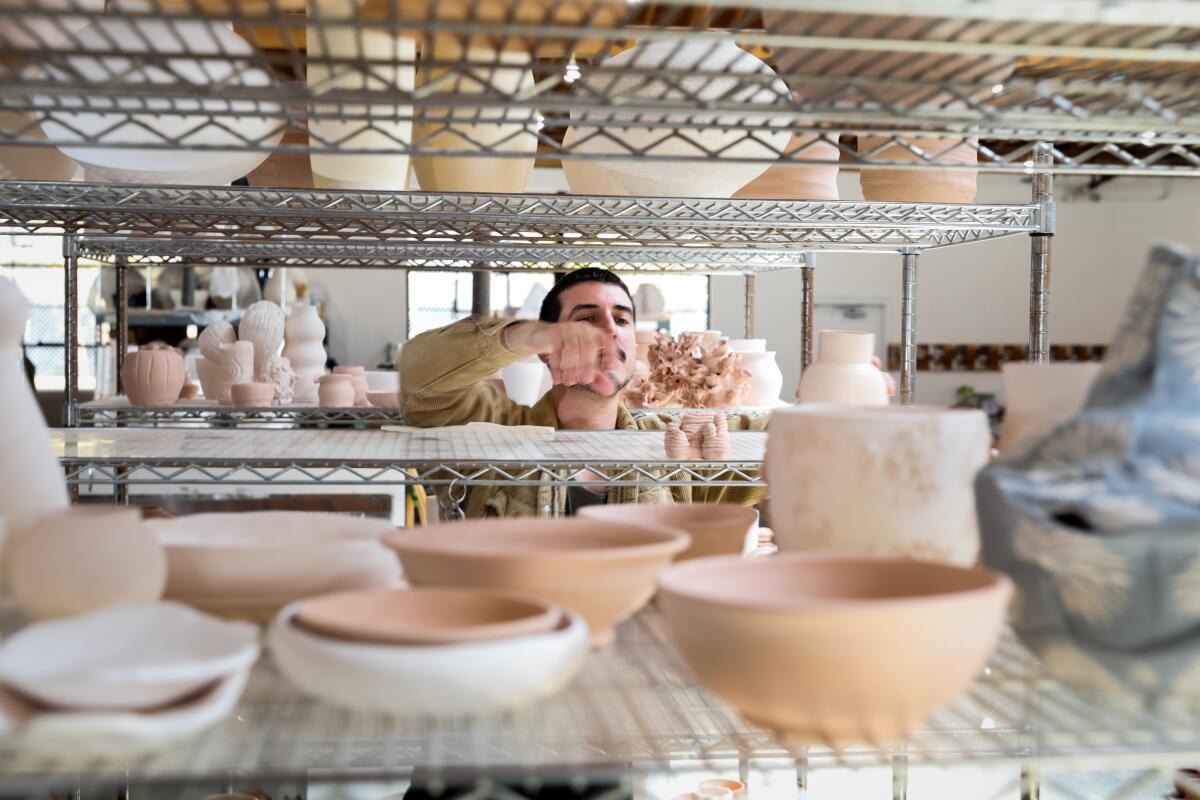
With locations in Culver City, Cypress Park, Sherman Oaks, Costa Mesa and San Francisco, the Pottery Studio offers introductory hand building and wheel throwing classes for anyone interested in getting their hands on some clay.
Classes cost $225 for four two-hour classes spread over the course of a month. Hand building classes cover the basics of making ceramics with slabs, coils and slump molds, and wheel classes cover centering, pulling walls, trimming and glazing. Clay and tools are provided with each class.
In addition to the weekly classes, students are encouraged to come in and use the space during their free time.
“We offer students practice times between 10 a.m. and 10 p.m. every day, except when there are other classes going on in the space,” said Kelley Burnett, the Pottery Studio’s general manager. “That really helps folks feel like they can come in and make the most of that class.”
After each month of classes is over, the Pottery Studio offers students a grace-period month when they can finish glazing and firing their pieces. And though most people need more than a month to make the mug or bowl of their dreams, the classes offer a solid start.
“I always tell people, ‘Go easy on yourself,’” Burnett said. “It can be hard and intimidating to learn new things as an adult, so just come into it being, like, ‘We’re here to have fun, and we’re gonna make something!’”
The Perfumer's Studio
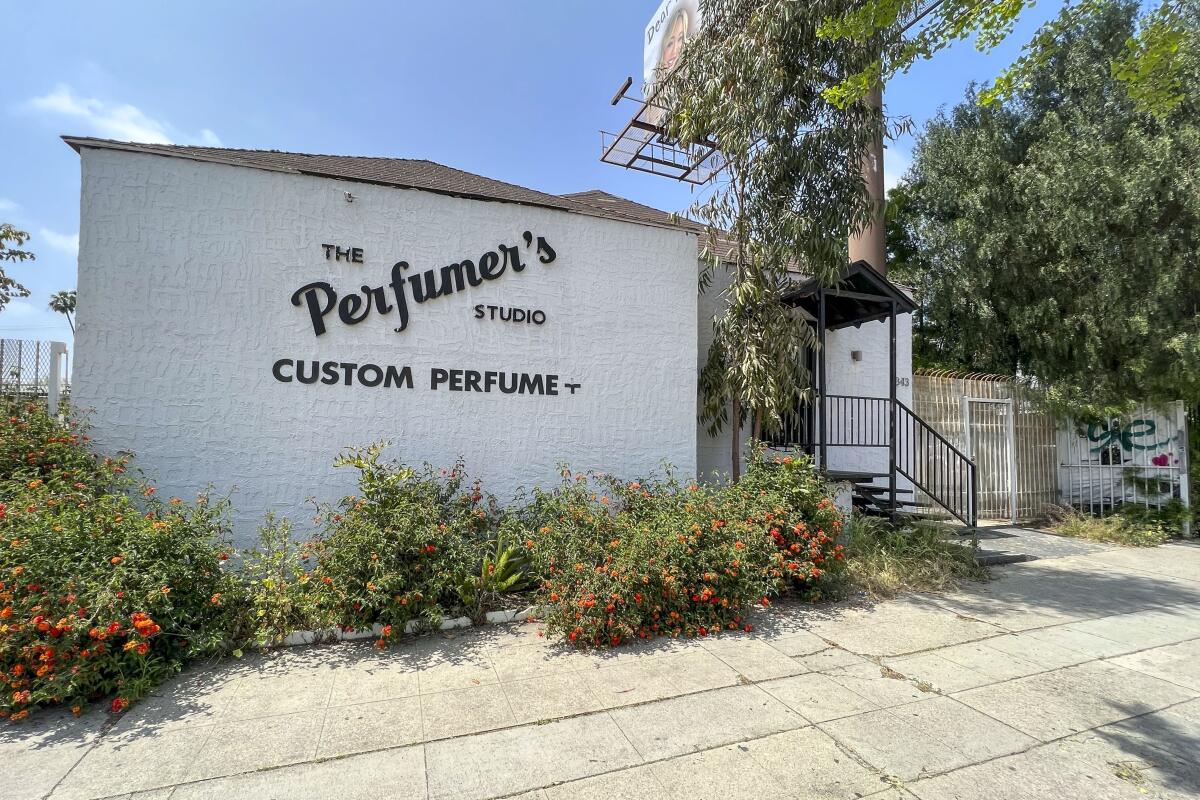
For those with a discerning nose, the Perfumer’s Studio offers 2½-hour workshops in which students can blend and take home a new signature scent.
“We teach them a little bit about what we call modifiers — top notes, base notes, citrus, wood,” said Tianna Mockett, head perfumer and manager of the Perfumer’s Studio. “They do some hands-on mixing, and we’re here to answer questions the whole time that they’re blending.”
Perfume Making 101 costs $245, and each student leaves with an ounce of a custom scent. For an extra $40, the Perfumer’s Studio offers Natural Perfume Making 101, teaching students about essential oil scent categories and sending them home with a roller bottle of their new fragrance. (Mockett noted that many people find natural perfumery more difficult.)
Mockett said that most classes max out at 12 students. Although some professionals are drawn to the higher-level courses, the studio always gives new students the chance to experiment and explore, she said.
“I try to encourage people to be a bit gentle with themselves,” Mockett said. “When they show up, it’s the first time that they’re creating a fragrance, right? So sometimes people come in with this idea that they’re going to create, like, the next Santal [33].
“But anybody, whether they have no experience or 30 years of experience, will be able to get something from it,” she added.



